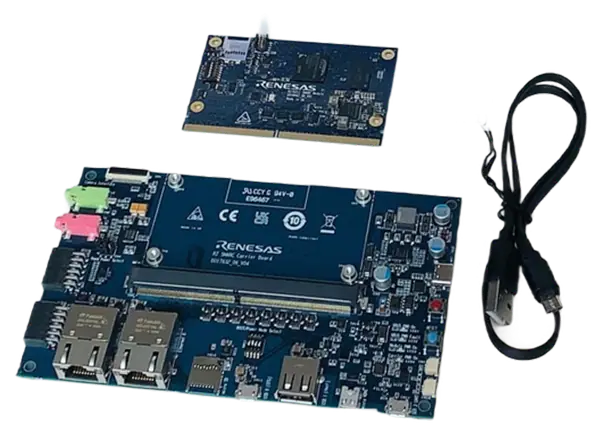
Renesas RZ/G2L
Installing dependencies
Yocto image preparation/patch/build for G2L
Renesas provides Yocto build system to build all the necessary packages and create the Linux image. In this section, we will build the Linux image with the nodejs/npm packages required by Edge Impulse CLI tools. Renesas requires using the Ubuntu 20.04 Linux distribution to build the Linux image. Please follow instructions provided here to setup your build environment for your G2L yocto build. These instructions will also provide you with the necessary bootloader settings required to boot your G2L from sdcard. In order to use the Edge Impulse CLI tools, NodeJS v18 needs to be installed into the yocto image that you build. Given the instructions called out here, once the following files are downloaded from Renesas (specific versions specified are required):Accessing the board using screen
The easiest way is to connect through serial to the RZ/G2L board using the USB mini b port.
- After connecting the board with a USB-C cable, please power the board with the red power button.
-
Please install
screento the host machine and then execute the following command from Linux to access the board: -
You will see the boot process, then you will be asked to log in:
- Log in with username
root - There is no password
- Log in with username
Installing Edge Impulse Linux CLI
Once you have logged in to the board, please run the following command to install Edge Impulse Linux CLIConnecting to Edge Impulse
With all software set up, connect your google coral camera to your Renesas board (see ‘Next steps’ further on this page if you want to connect a different sensor), and run:--clean.
Verifying that your device is connected
That’s all! Your device is now connected to Edge Impulse. To verify this, go to your Edge Impulse project, and click Devices. The device will be listed here.
Device connected to Edge Impulse.
Next steps: building a machine learning model
Currently, all Edge Impulse models can run on the RZ/G2L CPU which is a dedicated Cortex A55. In addition, you can bring your own model to Edge Impulse and use it on the device. However, if you would like to benefit from the DRP-AI hardware acceleration support including higher performance and power efficiency, please use one of the following models: For object detection:- Yolov5 (v5)
- FOMO (Faster objects More Objects)
- MobileNet v1, v2

Selecting the target from the training page
Deploying back to device
To run your impulse locally, just connect to your Renesas RZ/G2L and run:eim model that you can use with the above runner as follows:
Go to the deployment page and select:

EIM model for the RZ/G2L
runner and you will see both the camera feed and the classification results.